Closed Cell Rigid Polyurethane Foams Based on Low Functionality Polyols: Research of Dimensional Stability and Standardised Performance Properties
Abstract
1. Introduction
2. Experimental
2.1. Case Study
2.2. Raw Materials
2.3. Preparation of PET Waste-Based Polyurethane Foams
2.4. Test Methods Used for the Mixtures and Polyurethane Foam
3. Results and Discussion
3.1. Characteristics of the Mixtures and Apparent Density of the Foams
3.2. Dimensional Stability of the Products
3.3. Thermal Conductivity and Microstructure of the Stable Products
3.4. Moisture Properties of the Stable Products
3.5. Thermal Stability and Flammability Properties of the Stable Products
4. Conclusions
Author Contributions
Funding
Conflicts of Interest
References
- Soto, G.; Castro, A.; Vechiatti, N.; Iasi, F.; Armas, A.; Marcovich, N.E.; Mosiewicki, M.A. Biobased porous acoustical absorbers made from polyurethane and waste tire particles. Polym. Test. 2017, 57, 42–51. [Google Scholar] [CrossRef]
- Hu, S.; Wan, C.; Li, Y. Production and characterization of biopolyols and polyurethane foams from crude glycerol based liquefaction of soybean straw. Bioresour. Technol. 2012, 103, 227–233. [Google Scholar] [CrossRef] [PubMed]
- Hu, S.; Li, Y. Two-step sequential liquefaction of lignocellulosic biomass by crude glycerol for the production of polyols and polyurethane foams. Bioresour. Technol. 2014, 161, 410–415. [Google Scholar] [CrossRef] [PubMed]
- Yan, Y.; Pang, H.; Yang, X.; Zhang, R.; Liao, B. Preparation and characterization of water-blown polyurethane foams from liquefied cornstalk polyol. J. Appl. Polym. Sci. 2008, 110, 1099–1111. [Google Scholar] [CrossRef]
- Li, H.; Feng, S.; Yuan, Z.; Wei, Q.; Xu, C. Highly efficient liquefaction of wheat straw for the production of bio-polyo and bio-based polyurethane foams. Ind. Crops Prod. 2017, 109, 426–433. [Google Scholar] [CrossRef]
- Wang, H.; Chen, H. A novel method of utilizing the biomass resource: Rapid liquefaction of wheat straw and preparation of biodegradable polyurethane foam (PUF). J. Chin. Inst. Chem. Eng. 2007, 38, 95–102. [Google Scholar] [CrossRef]
- Li, H.; Xu, C.; Yuan, Z.; Win, Q. Synthesis of bio-based polyurethane foams with liquefied wheat straw: Process optimization. Biomass Bioenergy 2018, 111, 134–140. [Google Scholar] [CrossRef]
- Lee, S.; Teramoto, Y.; Shiraishi, N. Acid-catalyzed liquefaction of waste paper in the presence of phenol and its application to novolak-type phenolic resin. J. Appl. Polym. Sci. 2002, 83, 1473–1481. [Google Scholar] [CrossRef]
- Ge, J.; Zhong, W.; Guo, Z.; Li, W.; Sakai, K. Biodegradable polyurethane materials from bark and starch. I. highly resilient foams. J. Appl. Polym. Sci. 2000, 77, 2575–2580. [Google Scholar] [CrossRef]
- Lu, Y.; Tighzert, L.; Berzin, F.; Rondot, S. Innovative plasticized starch films modified with waterborne polyurethane from renewable resources. Carbohydr. Polym. 2005, 61, 174–182. [Google Scholar] [CrossRef]
- Aysu, T.; Durak, H. Assessment of avocado seeds (Persea americana) to produce biooil through supercritical liquefaction. Biofuels Bioprod. Biorefin. 2015, 9, 231–257. [Google Scholar] [CrossRef]
- Mahmood, N.; Yuan, Z.; Schmidt, J.; Xu, C. Preparation of bio-based rigid polyurethane foam using hydrolytically depolymerized kraft lignin via direct replacement or oxypropylation. Eur. Polym. J. 2015, 68, 1–9. [Google Scholar] [CrossRef]
- Wysocka, K.; Szymona, K.; McDonald, A.G.; Mamiński, M. Characterization of thermal and mechanical properties of lignosulfonate- and hydrolyzed lignosulfonate-based polyurethane foams. Bioresource 2016, 11, 7355–7364. [Google Scholar] [CrossRef]
- Gayer, R.; Jambeck, J.R.; Law, K.L. Production, use, and fate of all plastics ever made. Sci. Adv. 2017, 3, e1700782. [Google Scholar] [CrossRef]
- Ren, J.; Dyosiba, X.; Musyoka, N.M.; Langmi, H.W.; North, B.C.; Mathe, M.; Onyango, M.S. Green synthesis of chromium-based metal-organic framework (Cr-MOF) from waste polyethylene terephthalate (PET) bottles for hydrogen storage applications. Int. J. Hydrogen Energy 2016, 41, 18141–18146. [Google Scholar] [CrossRef]
- Padhan, R.K.; Gupta, A.A. Preparation and evaluation of waste PET derived polyurethane polymer modified bitumen through in situ polymerization reaction. Constr. Build. Mater. 2018, 158, 337–345. [Google Scholar] [CrossRef]
- Cakić, S.M.; Ristić, I.S.; Cincović, M.M.; Nikolić, N.Č.; Nikolić, L.B.; Cvetinov, M.J. Synthesis and properties biobased waterborne polyurethanes from glycolisis product of PET waste and poly(caprolactone) diol. Prog. Org. Coat. 2017, 105, 111–122. [Google Scholar] [CrossRef]
- Vitkauskiene, I.; Makuska, R.; Stirna, U.; Cabulis, U. Synthesis and physical-mechanical properties of polyurethane-polyisocyanurate foams based on PET-waste-derived modified polyol. J. Cell. Plast. 2011, 47, 467–482. [Google Scholar] [CrossRef]
- Phetphaisit, C.W.; Bumee, R.; Namahoot, J.; Ruamcharoen, J.; Ruamcharoen, P. Polyurethane polyester elastomer: Innovative environmental friendly wood adhesive from modified PETs and hydroxyl liquid natural rubber polyols. Int. J. Adhes. Adhes. 2013, 41, 127–131. [Google Scholar] [CrossRef]
- Fornasieri, M.; Alves, J.W.; Muniz, E.C.; Ruvolo-Filho, A.; Otaguro, H.; Rubira, A.F.; Carvalho, G.M. Synthesis and characterization of polyurethane composites of wood waste and polyols from chemically recycled pet. Compos. Part A Appl. Sci. Manuf. 2011, 42, 189–195. [Google Scholar] [CrossRef][Green Version]
- Jamdar, V.; Kathalewar, M.; Dubey, K.A.; Sabnis, A. Recycling of PET wastes using Electron beam radiations and preparation of polyurethane coatings using recycled material. Prog. Org. Coat. 2017, 107, 54–63. [Google Scholar] [CrossRef]
- Bedell, M.; Brown, M.; Kiziltas, A.; Milewski, D.; Mukerjee, S.; Tabor, R. A case for closed-loop recycling of post-consumer PET for automative foams. Waste Manag. 2018, 71, 97–108. [Google Scholar] [CrossRef] [PubMed]
- Dang, Y.; Luo, X.; Wang, F.; Li, Y. Value-added conversion of waste cooking oil and post-consumer PET bottles into biodiesel and polyurethane foams. Waste Manag. 2016, 52, 360–366. [Google Scholar] [CrossRef] [PubMed]
- Luo, X.; Li, Y. Synthesis and characterization of polyols and polyurethane foams from PET waste and crude glycerol. J. Polym. Environ. 2014, 22, 318–328. [Google Scholar] [CrossRef]
- EN 13165—Thermal Insulation Products for Buildings—Factory Made Rigid Polyurethane Foam (PU) Products—Specification; European Standardization Committee: Brussels, Belgium, 2016.
- EN 14315-1—Thermal Insulating Products for Buildings—In-Situ Formed Sprayed Rigid Polyurethane (PUR) and Polyisocyanurate (PIR) Foam Products—Part 1: Specification for the Rigid Foam Spray System before Installation; European Standardization Committee: Brussels, Belgium, 2013.
- EN 12085—Thermal Insulating Products for Building Applications—Determination of Linear Dimensions of Test Specimens; European Standardization Committee: Brussels, Belgium, 2013.
- EN 1602—Thermal Insulating Products for Building Applications—Determination of the Apparent Density; European Standardization Committee: Brussels, Belgium, 2013.
- EN 12667—Thermal Performance of Building Materials and Products—Determination of Thermal Resistance by Means of Guarded Hot Plate and Heat Flow Meter Methods—Products of High and Medium Thermal Resistance; European Standardization Committee: Brussels, Belgium, 2002.
- EN 1609—Thermal Insulating Products for Building Applications—Determination of Short Term Water Absorption by Partial Immersion; European Standardization Committee: Brussels, Belgium, 2013.
- EN 12086—Thermal Insulating Products for Building Applications—Determination of Water Vapour Transmission Properties; European Standardization Committee: Brussels, Belgium, 2013.
- EN 1604—Thermal Insulating Products for Building Applications—Determination of Dimensional Stability under Specified Temperature and Humidity Conditions; European Standardization Committee: Brussels, Belgium, 2013.
- EN ISO 4590—Rigid Cellular Plastics—Determination of the Volume Percentage of Open Cells and of Closed Cells; European Standardization Committee: Brussels, Belgium, 2016.
- Kurańska, M.; Prociak, A. The influence of rapeseed oil-based polyols on the foaming process of rigid polyurethane foams. Ind. Crops Prod. 2016, 89, 182–187. [Google Scholar] [CrossRef]
- Kairytė, A.; Vėjelis, S. Evaluation of forming mixture compositions impact on properties of water blown rigid polyurethane (PUR) foam from rapeseed oil polyol. Ind. Crops Prod. 2015, 66, 210–215. [Google Scholar] [CrossRef]
- Kairytė, A.; Vaitkus, S.; Vėjelis, S.; Pundienė, I. A study of rapeseed oil-based polyol substitution with bio-based products to obtain dimensionally and structurally stable rigid polyurethane foams. J. Polym. Environ. 2018, 26, 3834–3847. [Google Scholar] [CrossRef]
- Choe, K.H.; Lee, D.S.; Seo, W.J.; Kim, W.N. Properties of rigid polyurethane foams with blowing agents and catalysts. Polym. J. 2004, 36, 368–373. [Google Scholar] [CrossRef]
- Jin, F.-L.; Zhao, M.; Park, M.; Park, S.-J. Recent trends of foaming in polymer processing: A review. Polymers 2019, 11, 953. [Google Scholar] [CrossRef]
- Zhang, R.; Huang, K.; Hu, S.; Liu, Q.; Zhao, X.; Liu, Y. Improved cell morphology and reduced shrinkage ratio of ETPU beads by reactive blending. Polym. Test. 2017, 63, 38–46. [Google Scholar] [CrossRef]
- Zhang, J.; Hori, N.; Takemura, A. Optimization of preparation process to produce polyurethane foam made by oilseed rape straw based polyol. Polym. Degrad. Stab. 2019, 166, 31–39. [Google Scholar] [CrossRef]
- Hejna, A.; Kirpluks, M.; Kosmela, P.; Cabulis, U.; Haponiuk, J.; Piszczyk, Ł. The influence of crude glycerol and castor oil-based polyol on the structure and performance of rigid polyurethane-polyisocianurate foams. Ind. Crops Prod. 2017, 95, 113–125. [Google Scholar] [CrossRef]
- Członka, S.; Sienkiewicz, N.; Kairytė, A.; Vaitkus, S. Colored polyurethane foams with enhanced mechanical and thermal properties. Polym. Test. 2019, 78, 105986. [Google Scholar] [CrossRef]
- Członka, S.; Bertino, M.F.; Kośny, J.; Strąkowska, A.; Masłowski, M.; Strzelec, K. Linseed oil as natural modifier of rigid polyurethane foams. Ind. Crops Prod. 2018, 115, 40–51. [Google Scholar] [CrossRef]
- Jarfelt, U.; Ramnäs, O. Thermal conductivity of polyurethane foam – bets perfor-mance. In Proceedings of the 10th International Symposium on District Heating and Cooling, Göteborg, Sweden, 3–5 September 2006. [Google Scholar]
- Berardi, U. The impact of aging and environmental conditions on the effective thermal conductivity of several foam materials. Energy 2019, 182, 777–794. [Google Scholar] [CrossRef]
- Choe, H.; Choi, Y.; Kim, J.H. Treshold cell diameter for high thermal insulation of water-blown polyurethane foams. J. Ind. Eng. Chem. 2019, 73, 344–350. [Google Scholar] [CrossRef]
- Berardi, U.; Madzarevic, J. Microstructural analysis and blowing agent concentration in aged polyurethane and polyisocyanurate foams. Appl. Therm. Eng. 2020, 164, 114440. [Google Scholar] [CrossRef]
- Radzi, A.M.; Sapuan, S.M.; Jawaid, M.; Mansor, M.R. Water absorption, thickness swelling and thermal properties of roselle/sugar palm fibre reinforced thermoplastic polyurethane hybrid composites. J. Mater. Res. Technol. 2019, 8, 3988–3994. [Google Scholar] [CrossRef]
- Gómez-Rojo, R.; Alameda, L.; Rodríguez, Á.; Calderón, V.; Gutiérrez-González, S. Characterization of polyurethane waste for reuse in eco-efficient building materials. Polymers 2019, 11, 359. [Google Scholar] [CrossRef]
- Parcheta, P.; Głowińska, E.; Datta, J. Effect of bio-based components on the chemical structure, thermal stability and mechanical properties of green thermoplastic polyurethane elastomers. Eur. Polym. J. 2020, 123, 109422. [Google Scholar] [CrossRef]
- Sienkiewicz, N.; Członka, S.; Kairytė, A.; Vaitkus, S. Curcumin as a natural compound in the synthesis of rigid polyurethane foams with enhanced mechanical, antibacterial and anti-ageing properties. Polym. Test. 2019, 79, 106046. [Google Scholar] [CrossRef]
- Li, X. –B.; Cao, H.–B.; Zhang, Y. Thermal degradation kinetics of rigid polyurethane foams blown with water. J. Appl. Polym. Sci. 2006, 102, 4149–4156. [Google Scholar] [CrossRef]
- Chen, X.; Li, J.; Gao, M. Thermal degradation and flame retardant mechanism of the rigid polyurethane foam including functionalized grapheme oxide. Polymers 2019, 11, 78. [Google Scholar] [CrossRef] [PubMed]
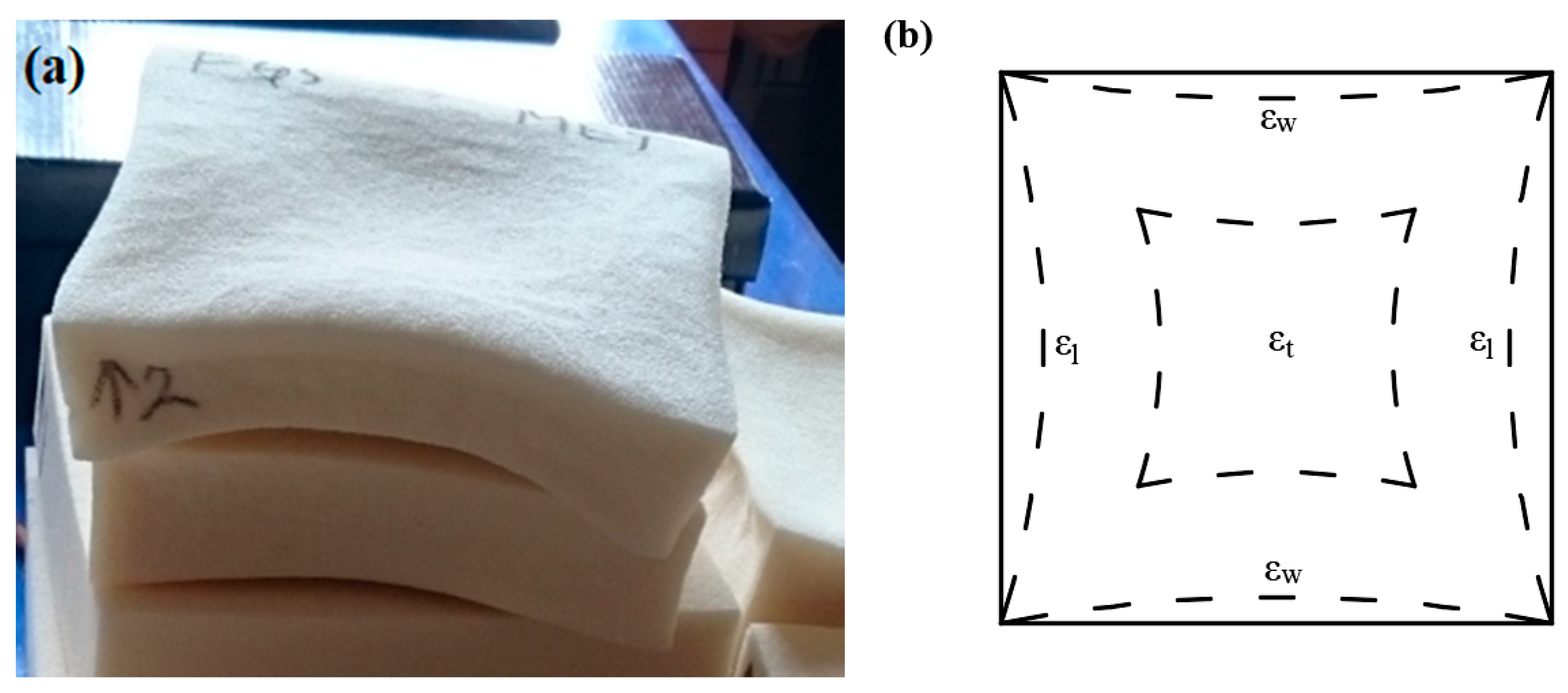
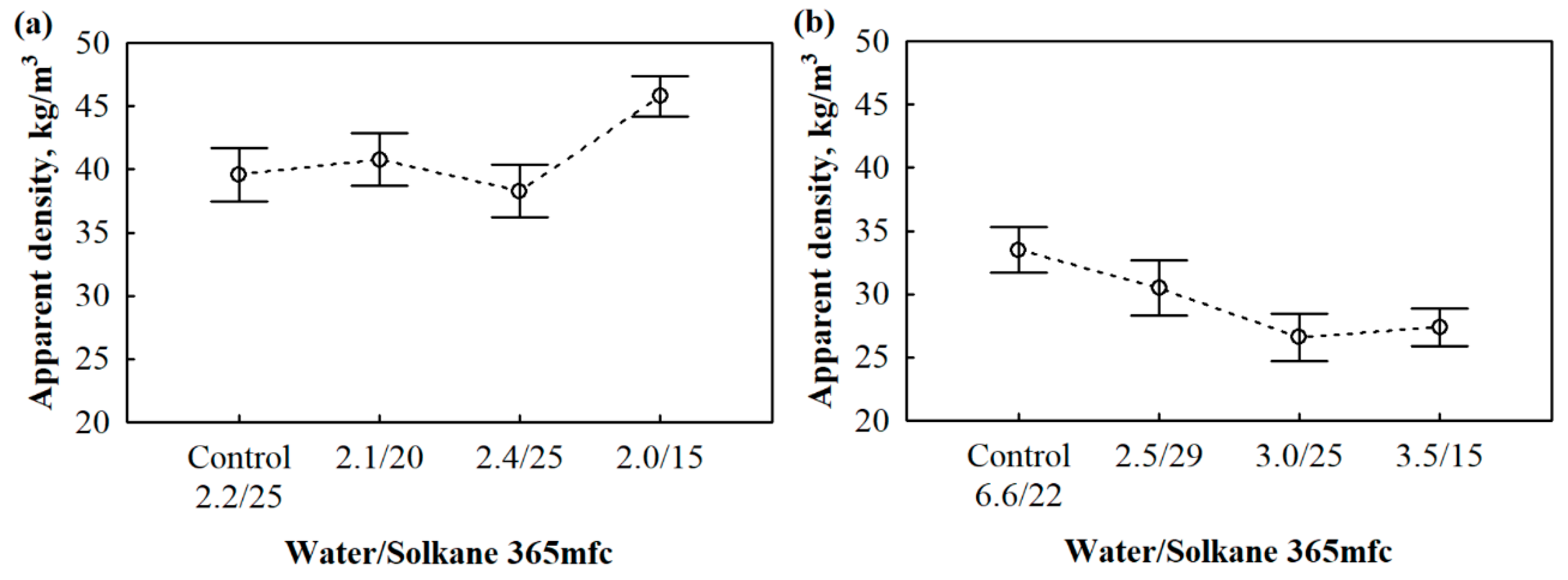
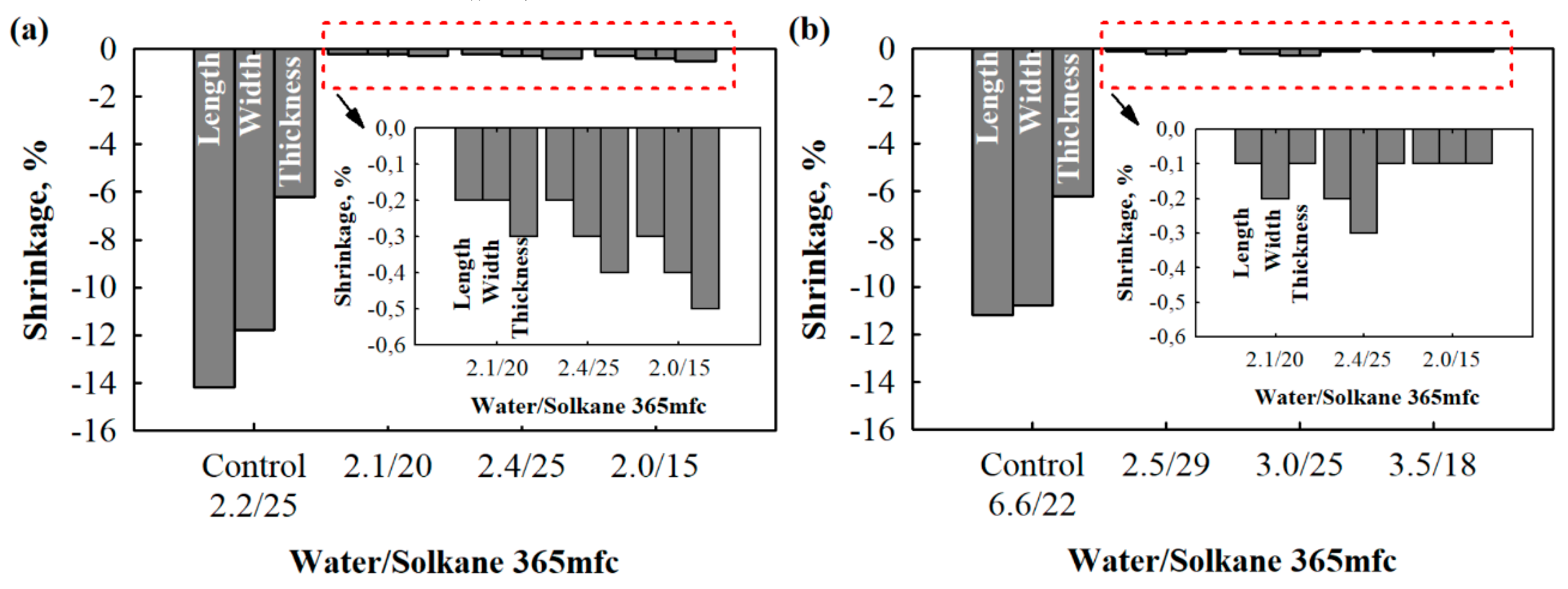
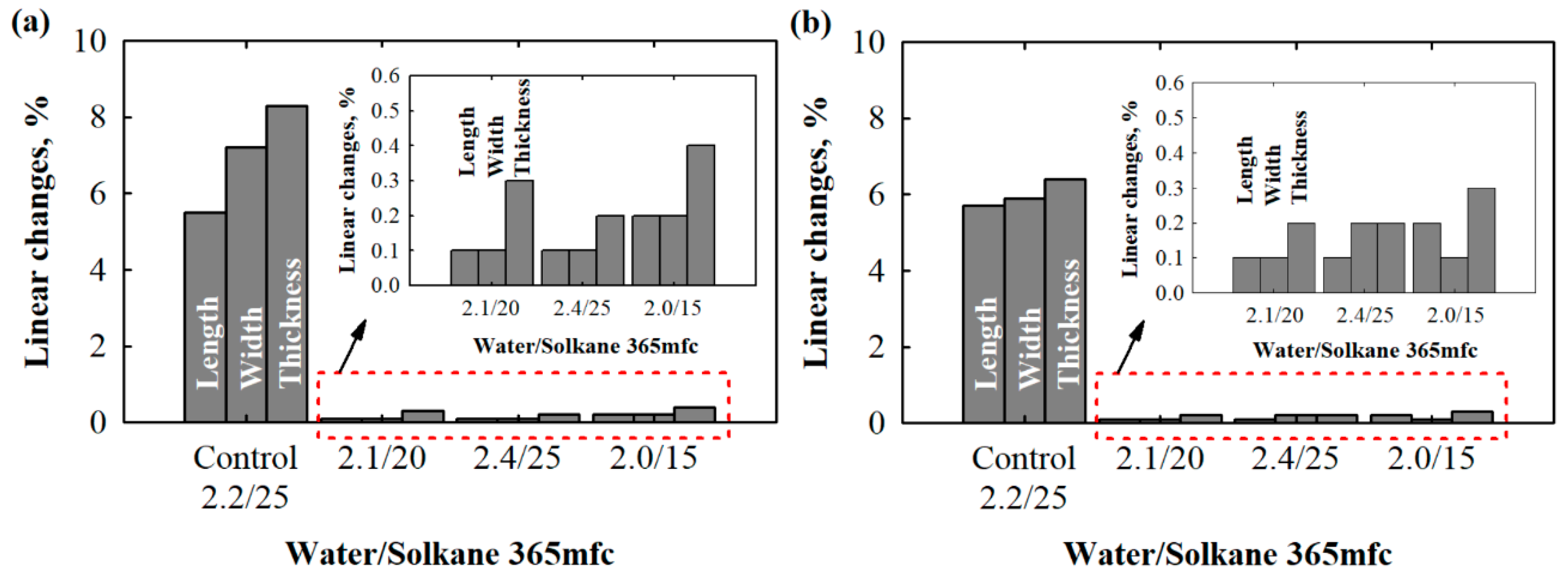
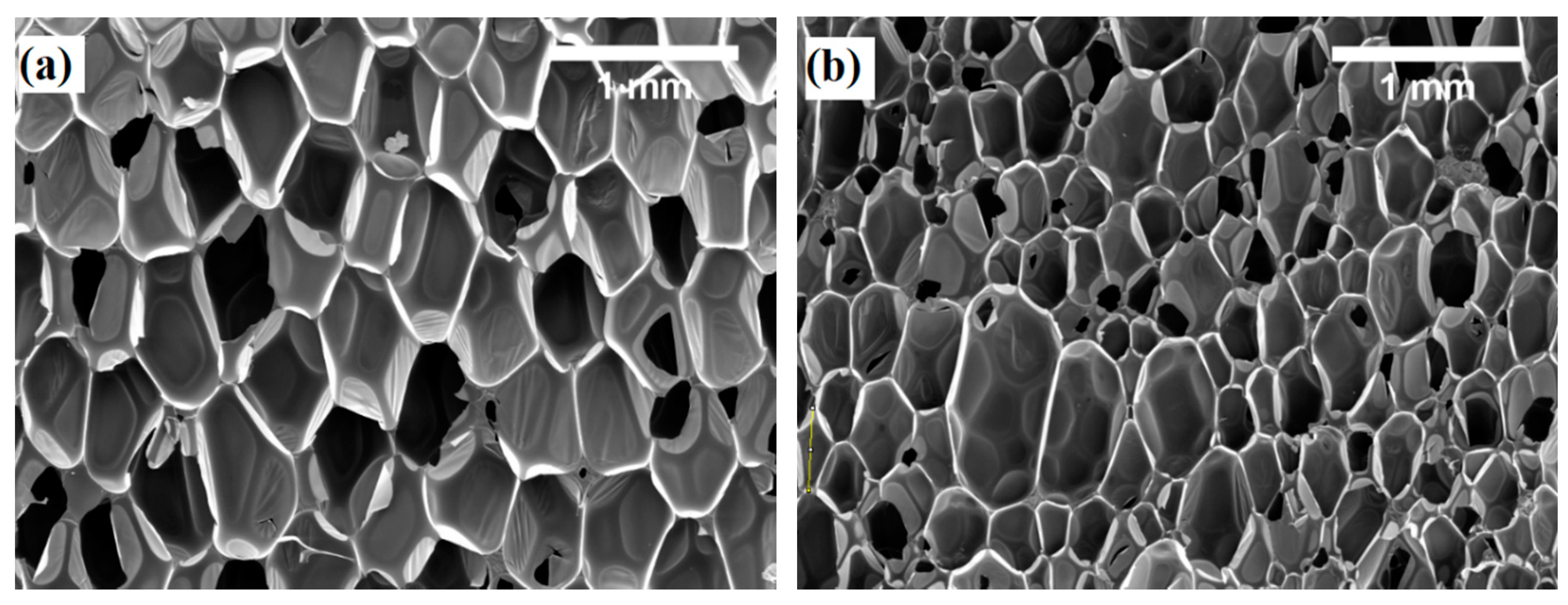
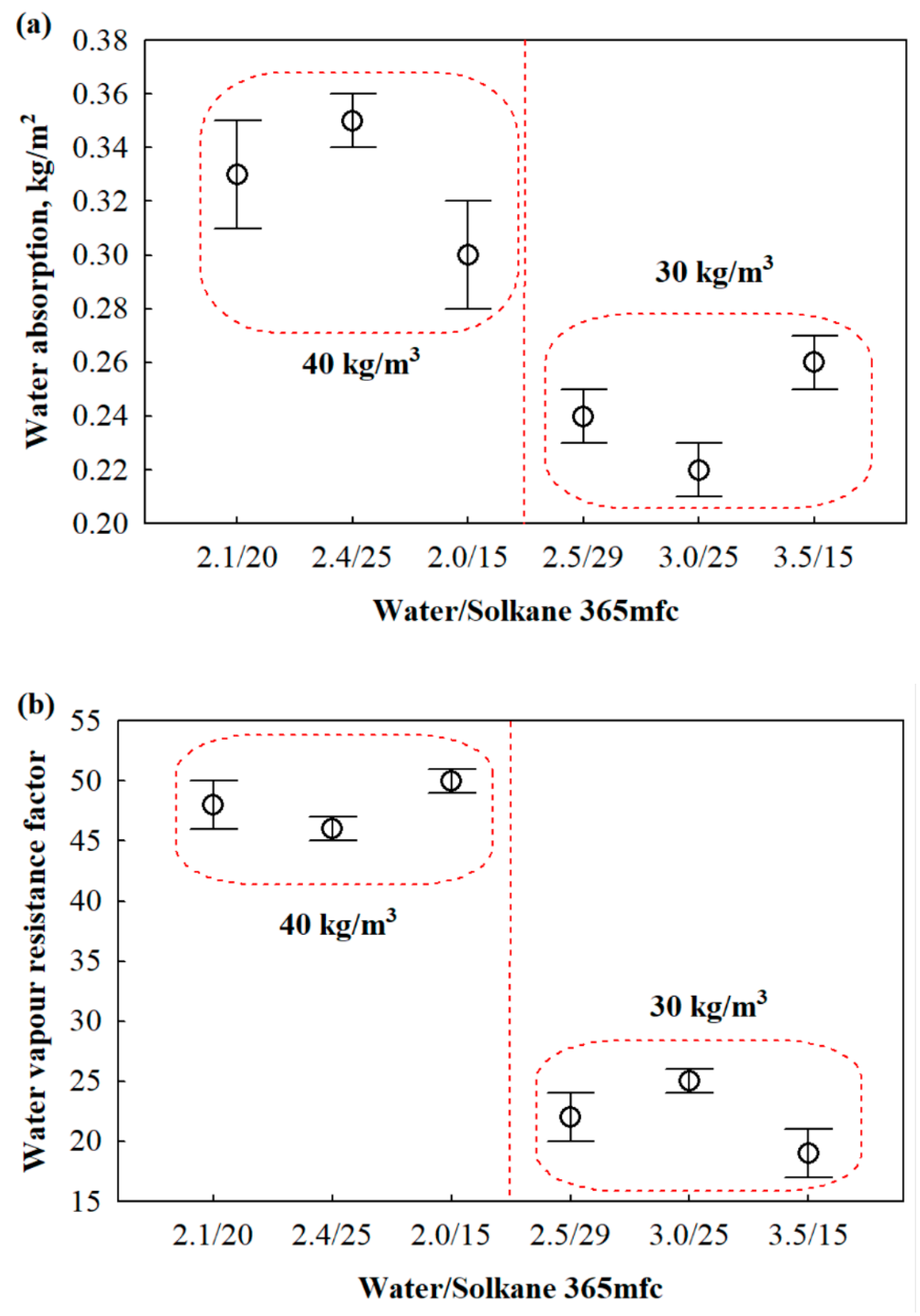
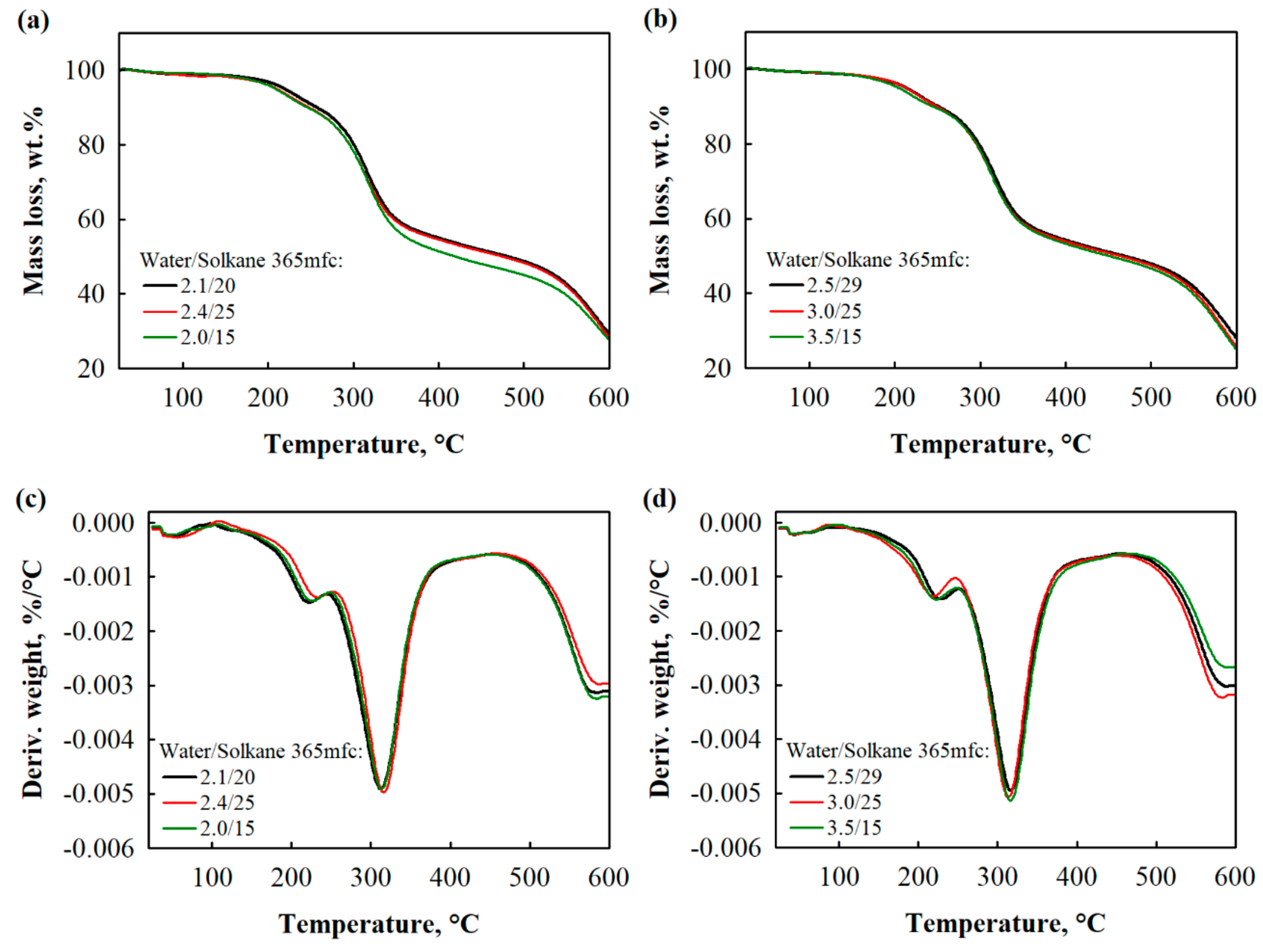
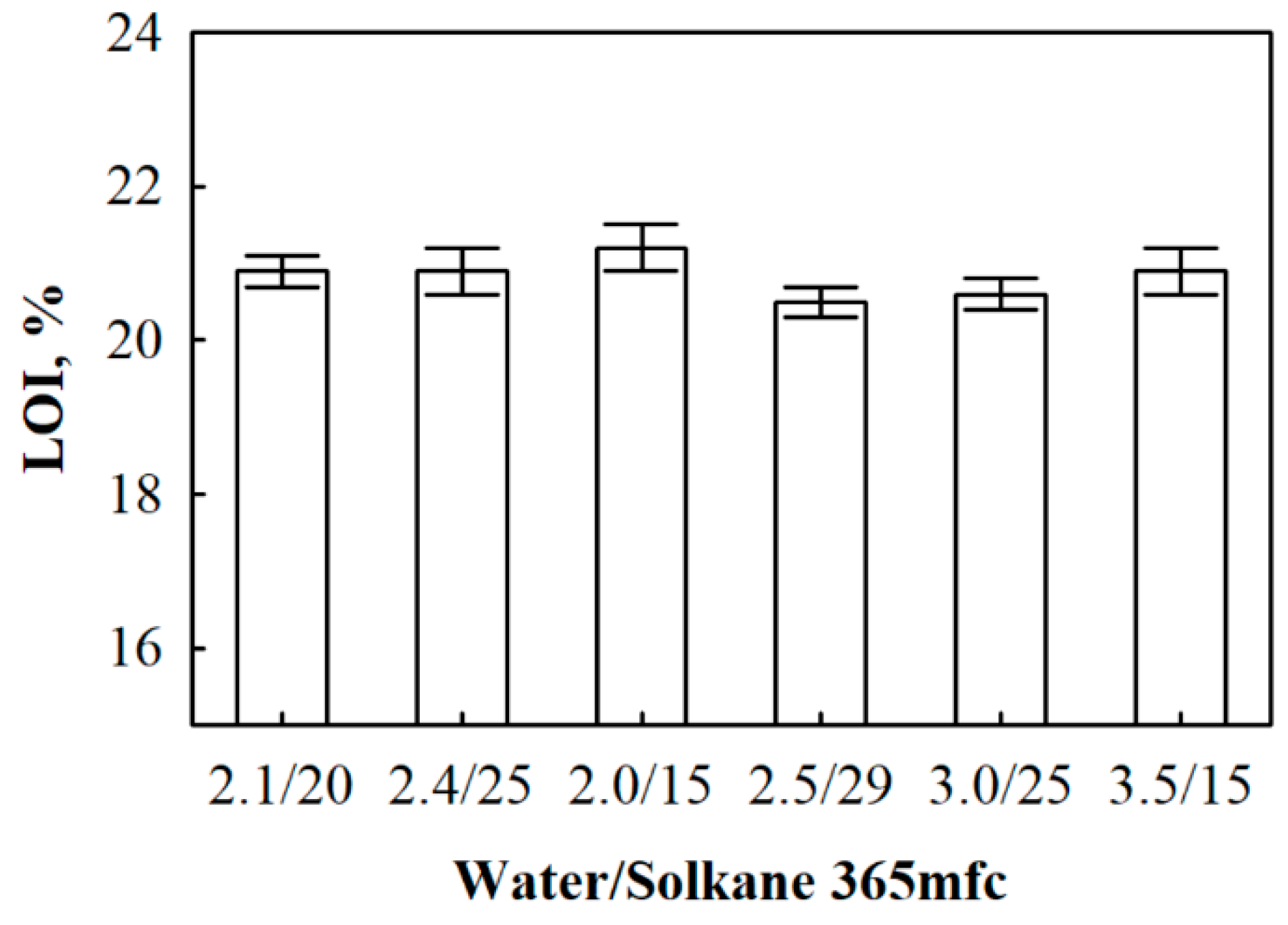
| Material | Required Density, kg/m3 | |
|---|---|---|
| 30 | 40 | |
| NEOPOLYOL 240 | 102.5 | 104 |
| Glycerol | 5.5 | 10.5 |
| PETOL PZ 400-4G | 36.5 | 34.5 |
| Water | 6.6 | 2.2 |
| Solkane 365 mfc | 22 | 25 |
| Struksilon 8007 | 2 | 2 |
| Polycat 9 | 4.2 | 4.2 |
| Roflam P | 44 | 37.5 |
| Parameter | Value | |
|---|---|---|
| NEOPOLYOL 240 | PETOL PZ 400-4G | |
| Hydroxyl value, mg KOH/g | 240 | 425 |
| Functionality, d. m. * | 2.1 | 4.3 |
| Density, g/cm3 | 1.23 | 1.10 |
| Dynamic viscosity at 25 °C temperature, mPa·s | 5250 | 7750 |
| Acid value, mg KOH/g | <1 | <1 |
| Water content, % | ≤0.1 | ≤0.1 |
| Material | 40 kg/m3 Water/Solkane 365 mfc | 30 kg/m3 Water/Solkane 365 mfc | ||||||
|---|---|---|---|---|---|---|---|---|
| Control 2.2/25 | 2.1/20 | 2.4/25 | 2.0/15 | Control 6.6/22 | 2.5/29 | 3.0/25 | 3.5/18 | |
| Amount, pbw | ||||||||
| Neopolyol 240 | 104 | 30 | 30 | 30 | 102.5 | 20 | 20 | 20 |
| Glycerol | 10.5 | - | - | - | 5.5 | - | - | - |
| Petol 400-4G | 34.5 | 70 | 70 | 70 | 36.5 | 80 | 80 | 80 |
| Water a | 2.2 | 2.1 | 2.4 | 2 | 6.6 | 2.5 | 3 | 3.5 |
| Solkane 365 mfc | 25 | 20 | 25 | 15 | 22 | 29 | 25 | 18 |
| Struksilon 8007 | 2 | 2 | 2 | 2 | 2 | 2 | 2 | 2 |
| Polycat 9 | 4.2 | 4.2 | 4.2 | 4.2 | 4.2 | 4.2 | 4.2 | 4.2 |
| Roflam P | 37.5 | 23 | 23 | 23 | 44 | 23 | 23 | 23 |
| Isocyanate index b | 100 | |||||||
| Blowing Agent Ratio, Water/Solkane 365 mfc | Parameter | |
|---|---|---|
| Calculated Hydroxyl Value of Polyols Systems, mg KOH/g | Calculated Functionality of Polyols Systems | |
| 40 kg/m3 | ||
| Control 2.2/25 | 394 | 2.68 |
| 2.1/20 | 370 | 3.64 |
| 2.4/25 | ||
| 2.0/15 | ||
| 30 kg/m3 | ||
| Control 6.6/22 | 347 | 2.69 |
| 2.5/29 | 388 | 3.86 |
| 3.0/25 | ||
| 3.5/15 | ||
| Blowing Agent Ratio, Water/Solkane 365 mfc | Cream Time, s | String-gel Time, s | Tack-Free Time, s | The Highest Reaction Temperature, °C |
|---|---|---|---|---|
| 40 kg/m3 | ||||
| Control 2.2/25 | 5 ± 2 | 15 ± 1 | 44 ± 1 | 108 ± 3 |
| 2.1/20 | 3 ± 1 | 13 ± 2 | 44 ± 2 | 110 ± 2 |
| 2.4/25 | 3 ± 1 | 13 ± 1 | 42 ± 1 | 114 ± 2 |
| 2.0/15 | 3 ± 1 | 13 ± 1 | 44 ± 2 | 115 ± 3 |
| 30 kg/m3 | ||||
| Control 6.6/22 | 4 ± 1 | 14 ± 1 | 43 ± 1 | 111 ± 2 |
| 2.5/29 | 3 ± 1 | 13 ± 1 | 43 ± 1 | 112 ± 2 |
| 3.0/25 | 3 ± 1 | 13 ± 1 | 41 ± 1 | 116 ± 3 |
| 3.5/15 | 3 ± 1 | 13 ± 1 | 41 ± 2 | 115 ± 2 |
| Blowing Agents Ratio, Water/Solkane 365 mfc | Polyols Ratio, Neopolyol 240/Petol PZ 400-4G | Average Thermal Conductivity before Ageing, W/(m·K) | Average Thermal Conductivity after Ageing, W/(m·K) | Average Closed Cell Content, vol.% | Average Cell Size, mm |
|---|---|---|---|---|---|
| 40 kg/m3 apparent density | |||||
| 2.1/20 | 30/70 | 0.0203 ± 0.0001 | 0.0259 ± 0.0004 | 91.3 ± 1.4 | 0.373 ± 0.052 |
| 2.4/25 | 30/70 | 0.0203 ± 0.0002 | 0.0259 ± 0.0004 | 90.4 ± 1.6 | 0.382 ± 0.048 |
| 2.0/15 | 30/70 | 0.0204 ± 0.0001 | 0.0264 ± 0.0001 | 91.6 ± 1.3 | 0.394 ± 0.092 |
| 30 kg/m3 apparent density | |||||
| 2.5/29 | 20/80 | 0.0201 ± 0.0001 | 0.0259 ± 0.0002 | 95.4 ± 2.0 | 0.784 ± 0.075 |
| 3.0/25 | 20/80 | 0.0203 ± 0.0001 | 0.0251 ± 0.0002 | 96.1 ± 1.8 | 0.788 ± 0.056 |
| 3.5/15 | 20/80 | 0.0198 ± 0.0003 | 0.0251 ± 0.0001 | 94.7 ± 1.4 | 0.782 ± 0.038 |
| Water/Solkane 365 mfc | T5 wt.%, °C | T50 wt.%, °C | Tmax, °C | Char Yield at 600 °C, wt.% | ||
|---|---|---|---|---|---|---|
| 1st Stage | 2nd Stage | 3rd Stage | ||||
| 40 kg/m3 | ||||||
| 2.1/20 | 220 | 481 | 219 | 313 | 582 | 29.4 |
| 2.4/25 | 210 | 476 | 232 | 316 | 585 | 28.5 |
| 2.0/15 | 210 | 421 | 228 | 310 | 583 | 27.8 |
| 30 kg/m3 | ||||||
| 2.5/29 | 214 | 468 | 225 | 318 | 589 | 28.2 |
| 3.0/25 | 213 | 464 | 222 | 312 | 585 | 26.0 |
| 3.5/15 | 205 | 452 | 224 | 320 | 592 | 25.1 |
© 2020 by the authors. Licensee MDPI, Basel, Switzerland. This article is an open access article distributed under the terms and conditions of the Creative Commons Attribution (CC BY) license (http://creativecommons.org/licenses/by/4.0/).
Share and Cite
Kairytė, A.; Kremensas, A.; Balčiūnas, G.; Członka, S.; Strąkowska, A. Closed Cell Rigid Polyurethane Foams Based on Low Functionality Polyols: Research of Dimensional Stability and Standardised Performance Properties. Materials 2020, 13, 1438. https://doi.org/10.3390/ma13061438
Kairytė A, Kremensas A, Balčiūnas G, Członka S, Strąkowska A. Closed Cell Rigid Polyurethane Foams Based on Low Functionality Polyols: Research of Dimensional Stability and Standardised Performance Properties. Materials. 2020; 13(6):1438. https://doi.org/10.3390/ma13061438
Chicago/Turabian StyleKairytė, Agnė, Arūnas Kremensas, Giedrius Balčiūnas, Sylwia Członka, and Anna Strąkowska. 2020. "Closed Cell Rigid Polyurethane Foams Based on Low Functionality Polyols: Research of Dimensional Stability and Standardised Performance Properties" Materials 13, no. 6: 1438. https://doi.org/10.3390/ma13061438
APA StyleKairytė, A., Kremensas, A., Balčiūnas, G., Członka, S., & Strąkowska, A. (2020). Closed Cell Rigid Polyurethane Foams Based on Low Functionality Polyols: Research of Dimensional Stability and Standardised Performance Properties. Materials, 13(6), 1438. https://doi.org/10.3390/ma13061438






